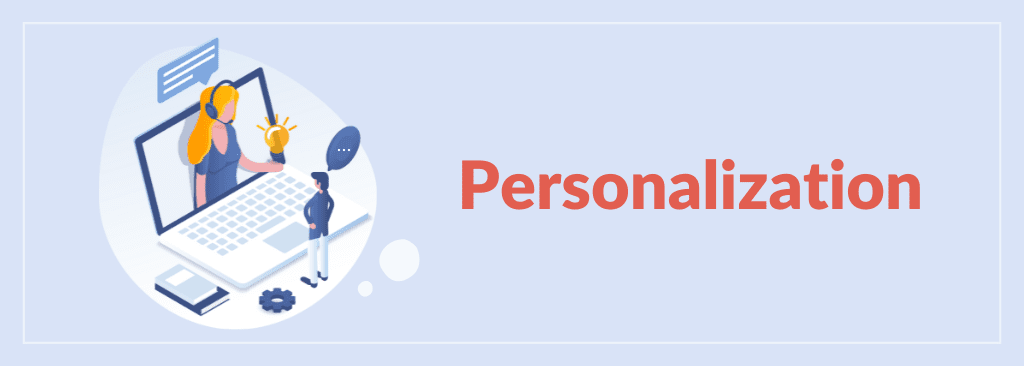Personalization With Relevance Is Key to a Great Customer Experience
McKinsey reports that 71% of consumers expect personalization, and 76% get frustrated when they don’t find it
Hubspot reports that personalized call-to-actions convert 202% better than default versions
91% of consumers are more likely to shop with brands that recognize, remember, and provide them with relevant offers and recommendations – Accenture research
Bombbomb.com reports these facts based on their experiments with a campaign team in a billion-dollar enterprise. Here are the findings:
- Personalization helped reduce the number of touchpoints from 10 to 3 for the lead response, which is a 70% improvement. It was primarily email, LinkedIn, and phone.
- The campaign response rate doubled from 15% to 33% with a personalized approach. In essence, 1 in 3 customers that they reached out to responded to the campaign
- Lead conversion into a qualified opportunity moved from 6% to 10%, which is a 60% jump with a personalized approach
- They attributed a $200 million additional pipeline increase in 12 months due to the personalized approach
- Their sales cycle was reduced by six months allowing the reps to run more campaigns in the given time
With a personal approach, they got many more insights than what they signed up for.
For instance, the customers don’t just say ‘no,’ they also say why they say ‘no,’ and what else they expect from them. These insights also helped them tweak their campaigns.
I heard all of these statistics in a podcast run by Ethan Beute of Bombbomb, and I thought this is very relevant to share and write about.
How Do We Go About Personalizing with Relevance?
Scenario 1
As a contact center agent, you get a call from a customer. With his number, you pull up all the information and say thus, “ Hello, Mr. X. I see that you have recently subscribed to our support service for your air conditioner. Thank you so much for that, and is this call related to that? I would be happy to assist you with anything.”
The customer would really love you for this. Most likely, they are calling to report an issue with their air conditioner, and you already have all the relevant details of the customer.
At the end of the call, the agent says, “I also see that you have looked up our vacuum cleaner but did not go ahead with the purchase. There is a 20% offer on the specific model that you looked up. Would you be interested?”
How do you think the conversation ended? Most likely, on a positive note.
You need to have a single view of your customers to offer this kind of personalization, for which you should opt for an omnichannel platform.
Scenario 2
Let us assume that you don’t have personal data about your customers. How do you personalize with relevance?
Take the case of an online shopping site. As soon as visitors see the option between Men’s and Women’s fashion, they choose one.
Assume they choose Men’s fashion, then you show them the sub-categories and price points. Based on the filters, you know what they are looking for, and your recommendation engine can throw suggestions around those filters besides looking at what people with similar interests bought.
Do you know that Amazon’s product recommendation engine contributes more than 30% of the e-commerce giant’s revenue?
This would throw up a ton of choices for customers about whom you don’t have personal data. After their visit, your cookies pick up their preference, and you can start to provide them with better suggestions in their subsequent visits.
Let Me Recount the Classic Example of Offline Personalization Run by Coke.
The ‘Share a Coke’ campaign was created by Ogilvy. Have you seen these labels:
- Share a Coke with Chris
- Share a Coke with Mike
With 50% of teens and young adults having not enjoyed a Coca-Cola in the previous month alone – they wanted to reconnect with their audience.
They printed 150 most popular Australian names on Coke bottles and cans and invited Australians to ‘Share a Coke.’
The rest is history.
This campaign ran in 80 markets from Australia to Vietnam, and it helped reverse an 11-year decline in consumption.
Have You Seen These Grammarly Personalized Reports?
Here is what I received this week.
- You were more productive than 92% of Grammarly users last week.
- You were more accurate than 81% of Grammarly users
- You used more unique words than 91% of Grammarly users
- The tone detected in your writing – confident, direct, and informative
- The top mistakes are – missing periods, commas, and commas in a series.
What is the point of this personalized report? The point is not just to make you look fantastic and identify mistakes but also to show the users how useful the app is for them – positioning it as a vital tool for content creators.
Does this work? I’d say Yes because I have been using this for the past 98 weeks.
Personalization, the word itself, means that it must address the needs of individuals and organizations.
Ensure that the personalization you offer as a part of your customer experience is relevant and meaningful by adding genuine value to your customers.
